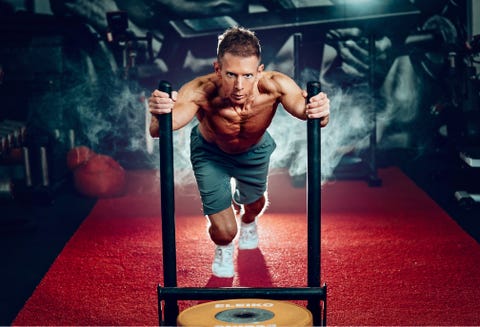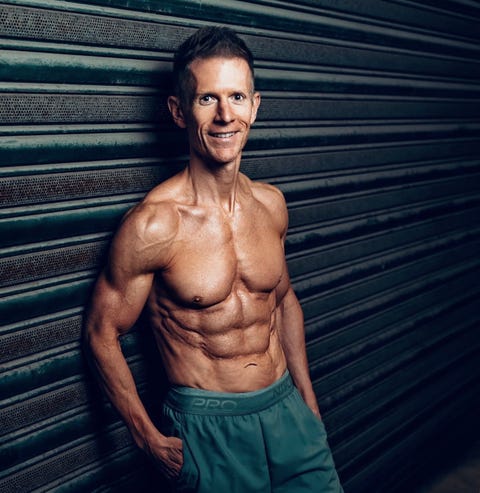Here’s How I Got Into the Best Shape of My Life in My Forties
Douglas Driscoll, a 43-year-old CEO from Sydney, Australia, shares his physical and mental transformation with Men’s Health.
As I’m sure is the case with most people, my weight gain happened gradually; I didn’t realize until it was too late. I was stuck in a bit of a rut and the combination of a poor diet, the pernicious affects of alcohol, and an increasingly sedentary lifestyle had a cumulative effect. I was actually still going to the gym three or four times per week, but I was just going through the motions and not putting in anywhere near enough effort.
I’m someone who has always kept myself in decent shape and taken pride in my appearance, so I definitely felt a sense of self-reproach. Rather than dwell on it and feel sorry for myself, however, I decided to take positive action. I knew that if nothing changes, then nothing changes. I found myself wasting far too much time looking at other people’s lives on social media, as opposed to getting up and getting after it myself.
I devised what I call my ‘brains and gains’ initiative, whereby I would spend at least one hour per day dedicated to academic development, and another hour dedicated to resistance training. Whether it be personally or professionally, I have always been very goal-orientated, so when I made the conscious decision to get back into shape, I knew that it needed to be tangible, as you cannot manage what you cannot measure. Rather than merely just having some vague fitness goal, I set myself the ambitious target of getting down to 8% body fat, while simultaneously increasing muscle mass.
Historically, I had always worked out on my own, but I realised that if I was to get into the best shape of my life, then I would need to enrol the help and support of the best in the business, which is why I turned to Nick Ellaway and the team at Ultimate Performance in Sydney. Although I have always been extremely self-motivated, they gave me that extra impetus and held me very accountable. I know that it’s a bit cliched, but I genuinely believe that motivation is what gets you started, but it’s discipline that keeps you going.

That meant making some serious sacrifices when it came to my diet, as it’s true what they say – a six-pack is made in the kitchen, not in the gym. As tough as it was, I immediately cut out all processed food and reduced alcohol consumption almost altogether. In consultation with professional nutritionists and the team at Ultimate Performance Sydney, we developed a tailored, protein-rich nutrition plan. I became very fastidious about everything I consumed and diligently tracked my calories and nutrients using the My Fitness Pal app.
Managing my appetite was certainly very challenging, so finding satiating food while adhering to a heavily calorie-controlled diet was essential. Thankfully, protein is shown to be the most satiating macronutrient and is thought to have the highest thermic effect. I tried my best to mix things up, but my staple diet became chicken. I started to eat so much chicken, I was worried that I might start sprouting feathers! I would always have a generous portion of greens every day as an accompaniment, as not only are they a healthy form of appetite suppressant, they also help reduce the risk of cardiovascular disease and diabetes. When I got peckish between meals, I would snack on a punnet of berries.
As for my workouts, I was doing high-intensity resistance training five to six times per week, working with my trainer twice a week and then doing the remaining sessions on my own. Come rain or shine, I would also walk or run 12 km every day.

Let’s face it, everyone’s a self-professed health and fitness expert and I was no different, so it was really important for me to have an open mind and to trust the process; otherwise what’s the point in engaging a trainer in the first place. Nick is a stickler for detail, and helped eradicate any bad habits and soon had me executing every rep with perfect form. Not only would he explain the physical function of each exercise, he would also educate me on the mechanics, which was real eye-opener for me. The mechanics seem to be the most overlooked, misapplied and misunderstood aspect of performing any exercise, yet are arguably the most important.
Over the course of 14 weeks, I lost nearly 9 kgs (19.8 pounds) in fat mass and reduced my body fat by 8%, while adding around 1 kg (2.2 pounds) of lean muscle.

For me, this wasn’t just one of those body transformation challenges, it was more about making lasting changes to both my lifestyle and mindset. Being my own boss, self-motivation can sometimes be a challenge, so a welcome side effect is that I have become incredibly structured and disciplined again, not just in my training, but with my work. I have also seen an improvement in cognitive function – I just feel so much sharper.
I often say that I hate the thought of having to go to the gym, but I definitely hate the feeling of not going even more. Regular exercise definitely helps improve my mood and decreases any feelings of anxiety or stress. Whereas before I would have persistent fatigue, I definitely have more energy now and am just generally more positive.

I cannot stress how difficult it was to achieve my goal, but I’m so proud of myself for doing so. That said, it’s unrealistic to maintain that body composition year round, nor would I necessarily want to. Moving forward, it’s about finding that all important balance between lifestyle and fitness. My reverse diet has gone exactly to plan and five months on, I am pleased to report that I am still in fighting shape and now around 10% body fat. I now consume approximately 2,600 calories per day. I still work out four to five times per week, and now average 10 km a day.
To anyone who is at the start of their own journey, I would say; the hardest thing about getting started, is actually getting started. My advice is to be very clear on your objectives from the outset and then set a series of mini-goals. These need to be realistic, measurable and achievable. I would highly recommend using an app that tracks your diet and exercise. If you have the financial means to do so, recruit a personal trainer to help you. This will immediately provide some accountability. If you’ve booked and paid for a session with a personal trainer, you are far more likely to turn up to the gym. Do your research though and look for one with a proven track record. And finally, do not underestimate how important your daily steps are. Taking a long walk each day is one of the easiest ways to improve your fitness. It doesn’t cost anything either.
Source: Read Full Article


